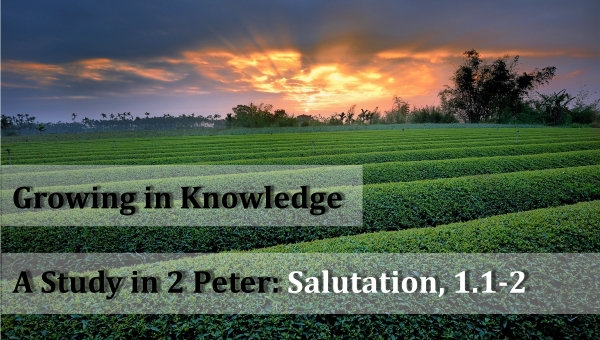By Tyson Thorne

Last week we barely got started, but start we did, a study of Peter’s second letter. The takeaway from our introduction is Peter’s Big Idea, that as we patiently wait for our Savior’s return we combat apostasy be increasing in our knowledge of God. During this study, I’ll be using a free online study tool from Faithlife. At the end of our study I’ll be reviewing the tool and its suitability for use in a group setting. But that comes later, today we are furthering our understanding of 2 Peter and there is no better place to start than with the salutation.
Like all letters of its day, this one begins by identifying the sender and the recipients. This one, though, is a bit different from most. Paul’s letters are written to specific churches, the church of Corinth, or Ephesus for example. This one is addressed to believer’s generally rather than a specific group, indicating Peter wrote this to be distributed to all believers everywhere. Why is this important? Think about it, you might mention some things to one group that you wouldn’t to another, simply because each group (or church) has different problems and different needs. On the other hand, when writing to a much larger group you concern yourself with the big picture. You stick to teachings that impact everyone. This makes 2 Peter especially valuable to believers today.
Normally one begins a study of this kind by discussing the historic and cultural context, and we’ll look at some of that when it applies, but in this case we are in the same position as the original readers. We all know about the Messiah, we all have heard or witnessed his sacrifice that makes the forgiveness of our sins possible, we all have received the Holy Spirit, we all are responsible for growing our faith and leading others to do the same, and we are all waiting for the second coming of Yeshua. Our historical and cultural setting, is very similar to that of the original readers.
The one big difference between us and them is language. Peter wrote in Greek, and while translations help us overcome that difference there are subtleties that sometimes escape even the best English versions. Take, for example, Peter’s description of himself. Some translations use the word “slave”, others “servant” but the best word choice here is “bondservant”. The reason most translations don’t use the later term is because modern readers have difficulty understanding the idea that word names. A bondservant is one who willingly sells himself into the service of another, which is what each of has effectively done when we come to Jesus. Slavery is not a bad word choice, and truthfully the Greek word used here (doulos) can mean slave, or servant too. But the word slave, in a modern context, is a position one is forced into, not something willingly taken upon oneself. The word servant, on the other hand, indicates willingness but also the ability to end the relationship, which isn’t applicable here.
Peter, a bondservant of the Christ, writes to all believers who share the same in the same grace and faith as the original apostles. And here in verse two he discloses a part of his purpose in writing, that they might experience a greater fullness of the knowledge of God. “The phrase “to grow in” is supplied here in English though it is not in the original Greek, but it is an acceptable translation addition. In the original knowledge is like “grace” and “peace” something that is lavished upon us. Unlike grace and peace, however, knowledge does not come all at once and this too is indicated in the Greek, so “to grow in” is supplied to keep the original intent in tact.
We take this deep dive into understanding the introduction of this letter because it sets the tone and purpose of everything that is to come. This will play out tomorrow and in the next few posts as we continue “to grow in knowledge” of Peter’s teachings.
|
|
